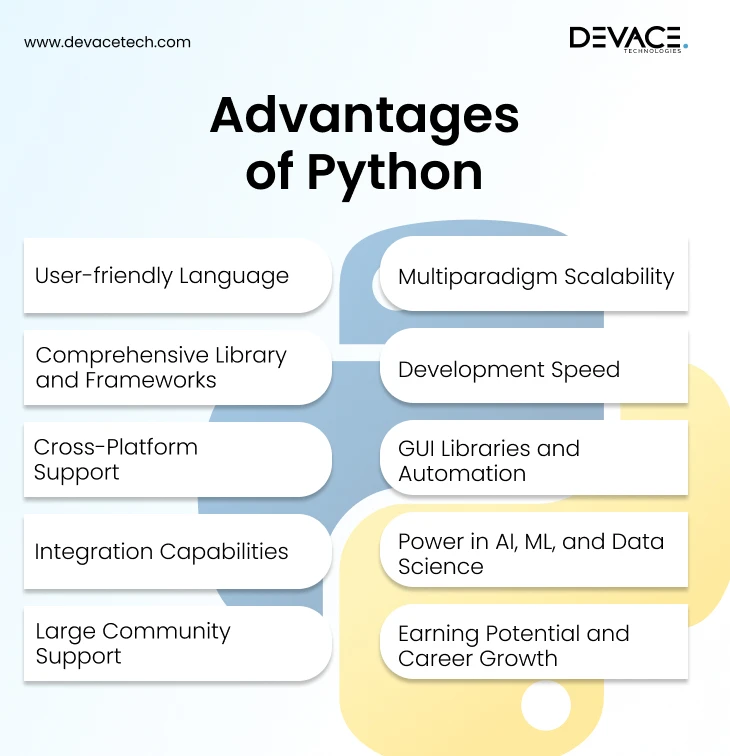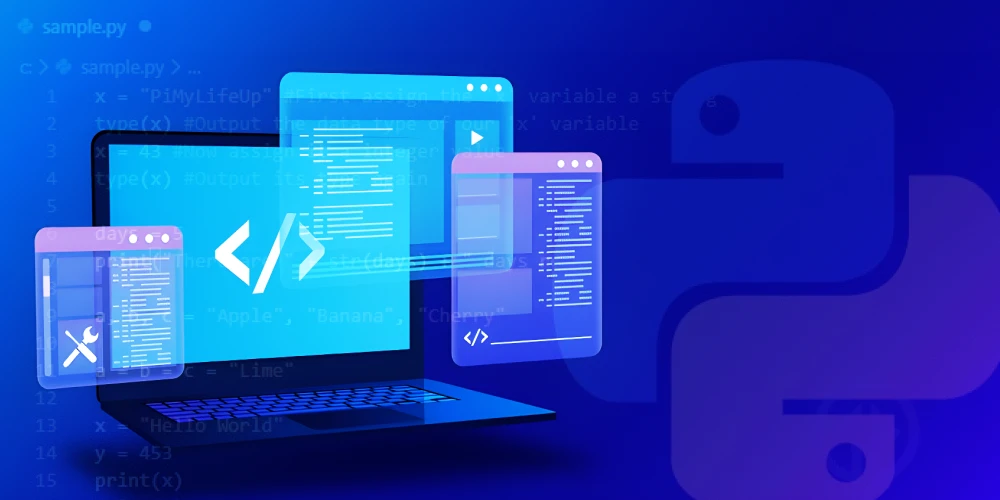Since its first release in 1991, Python has become one of the most widely used and influential programming languages worldwide. Python’s versatility, simplicity, and dynamic semantics are behind its rising adoption in data science and AI. Despite its popularity, it’s important to understand Python pros and cons you might have when you opt for this language. To know all such details, let’s read this blog.
What is Python Used For?
It’s a highly versatile scripting language used across multiple fields due to its readability, robust ecosystem, and simplicity. It plays an important role in data science, where it is utilized for statistical modeling, visualization, and data manipulation with libraries such as NumPy or Pandas.
In AI and Machine Learning (ML), Python is used for powering the development and training of models with Python frameworks like PyTorch and TensorFlow. Moreover, Python is also suitable for designing desktop applications in software development, in finance for data analysis and algorithmic training, and in cybersecurity.
Pros and Cons of Python: A Comprehensive Table
You can have a look at the given table to easily understand all the pros and cons of using Python for web development:
| Pros of Python | Cons of Python |
|---|---|
| User-friendly language | Due to slow interpretation and execution speed |
| Extensive Python frameworks & libraries | Not recommended for Mobile development |
| Backs various paradigms | Memory consumption is high |
| Active community | Typing may lead to runtime errors |
| Cross-platform support | Limited multi-threading |
| Suitable for rapid prototyping | Weak performance especially in gaming apps |
| Smooth integration with other languages | Version management and deployment challenges |
Strong support in:
|
Not ideal for real-time apps |
| Development capabilities-GUI | Cross-platform inconsistency |
Pros of Python Programming Language
Here we have collected some key Advantages of Python that you can get if you opt for Python for your web development projects, including ease of use, comprehensive frameworks, cross-platform support, integration capabilities, community support, and many more.

1. User-friendly Language
The clean and readable syntax of Python is one of the other Python advantages. It reduces the learning curve for beginners, making Python a user-friendly language. For seasoned developers, it ensures easier debugging and faster web development. Moreover, unlike other coding languages such as Java or C++, Python code is simple and concise, making tasks to be written in fewer code lines.
2. Comprehensive Library and Frameworks
A powerful standard library is associated with Python. It has built-in support to take care of file I/O management, date and time manipulation, interpreting data formats such as XML or JSON, and connecting web servers. Also, Python’s functionality is extended to some particular domains with third-party libraries through PyPI. You can hire dedicated Python developers who can select frameworks like Flask or Django for working on RESTful APIs.
3. Cross-Platform Support
The open-source nature of Python makes it available for use without specific subscriptions. Its availability on all operating systems like Windows, macOS, and Linux facilitates access and development process later on. Moreover, this cross-platform support offers transparency and collaborative development. Developers can easily install, do modifications, and distribute Python promoting innovation.
4. Integration Capabilities
Another benefit of using Python is its integration capabilities with other programming languages. Integration is facilitated with different modules such as Jython or Cython and integration tools like Boost and SWIG. Moreover, developers integrate with Java, C++, or R to leverage the best of every language.
Do you find language integration difficult?
5. Large Community Support
In comparison with other programming languages, Python has one of the most active and strong communities of developers. It makes active forums, extensive documentation, an abundance of learning resources, and regular updates possible. Tech giants like Netflix, Instagram, Dropbox, and Google support Python, ensuring long-term viability.
6. Multiparadigm Scalability
Multiple programming paradigms, such as functional, object-oriented, and procedural paradigms are supported by Python. In this way, developers can effectively solve problems related to programming with Python commands.
7. Development Speed
It’s a huge benefit of Python that you can ensure rapid web development speed. In record time, developers can move from the idea to the main prototype with Python. All thanks to Python’s modularity and simplicity, making it an ideal choice for innovation teams and startups.
8. GUI Libraries and Automation
Multiple Python GUI libraries are offered by Python, such as Kivy, Tkinter, and PyQt, for designing web applications. Moreover, Python excels in automation. Various complex system tasks can be automated with Python with the help of modules like shutil, subprocess, and os.
9. Power in AI, ML, and Data Science
For data scientists, Python best practices become de facto standards. Different Python libraries like TensorFlow, PyTorch, scikit-learn, and Keras provide dynamic tools for machine learning (ML) and deep learning. Also, Python allows exploration and data visualization coupled with Jupyter Notebook.
10. Earning Potential and Career Growth
Worldwide, Python consistently ranks as one of the widely used and highest-paying programming languages. Its applicability and flexibility make it a language that is always in demand among web developers. Whether you are a beginner or a programming expert, Python skills would be beneficial for your career advancement.
Cons of Python Programming Language
Some key disadvantages of Python include slow execution speed, high memory consumption, typing risks, GIL, development challenges, and many more.

1. Slow Execution
Being an interpreted language Python interprets code line by line rather than compiling the complete program at once like Java or C++. A slower runtime performance can be achieved by introducing overhead, particularly for CPU-bound tasks such as image processing, machine learning, and mathematical calculations. Although performance enhancing tools can be used by developers it needs extra efforts to defeat the simplicity of Python syntax.
2. High Consumption of Memory
One of the other cons of Python is its high memory usage. Moreover, opting for high-level data structure and Python consumes more memory. For instance, generating thousands of objects or taking care of large datasets in memory-heavy environments may result in crashes or performance slowdowns. This one is specifically an issue in areas like IoT, mobile apps, and embedded systems.
3. Not Ideal for Mobile App Development
For backend development Python is widely used, however, when it comes to mobile applications development it’s not an ideal choice. It lacks industry-level tools and frameworks to develop mobile apps. Although projects like PyQt, Kivy, or Beeware but don’t have community support, performance, and maturity of native tools such as Kotlin or Swift. That’s why Python is rarely considered a suitable choice for mobile app development.
4. Typing Risks
The dynamically typed nature of Python enables variables to shift types at runtime. Although with increasing flexibility the risk of runtime errors also rises. Such errors may come in the way of static type checkers in programming languages like C++ or Java. It is especially riskier in the case of large-scale web applications where an individual developer’s changes can introduce bugs. Such risks may be reduced but the burden is on developers.
5. Python’s GIL
The interpretation of various threads in Python can be restricted by a mechanism called Global Interpreter Lock (GIL). So, by restricting, it ensures the interpretation of Python bytecode by only one thread at a single time. This way performance of multi-threaded CPU-bounded applications is limited by introducing additional complexity.
6. Not Suited for Client-side Development
Although Python is best fitted for backend web development, it falls short on client-side web development. It is dominated by JavaScript and its popular frameworks such as React, Angular, and Vue. While other efforts such as Transcrypt and Brython focus on bringing Python to the browser they are not adopted widely or are not mature enough. That’s why web developers must select other programming languages to take care of the front-end part of their web projects.
7. Development Issues
Another disadvantage of using Python is that you may face development challenges while building web applications, particularly while working in complex web environments. Such development issues include platform-specific package compatibility, version mismatches, and dependency conflicts. While you can isolate the environment with tools like Docker containers, pipenv, and virtualenv handling them adds more responsibility.
8. Poor Performance in Real-time Apps
Applications that require real-time performance such as instant messaging platforms, virtual multi-player games, and high-frequency trading systems cannot work properly with Python. Moreover, this language’s interpreter overhead and garbage collection can make it difficult to meet time constraints by introducing latency. Other languages like Java, C++, or Rust are packed with better characteristics to manage real-time applications.
9. Operating System Dependency
Across multiple operating systems, Python’s behavior may vary due to changes in available libraries, path formats, default configurations, and file systems. For example, if a system operates efficiently on Linux, it might face difficulty on macOS or Windows. Cross-platform compatibility issues might arise this way, requiring extra effort for environment configuration, debugging, and testing.
10. High-End Gaming-Limited Usage
Certain Python libraries, such as Pygame are used to develop simple 2D games and in game development education. However, it lacks graphical capabilities, performance, and raw power, which is essential for AAA game development.
Coding languages that offer high frame rate performance and tight memory management are suitable for major game engines like Unity (C#) and Unreal Engine (C++). For 3D game development, Python is not suitable due to its restricted 3D engine support and slower execution time.
Why Should You Choose Python for The Next Project?
Are you still confused about when Python became popular and why you should choose it for your next project? Here we have collected some key reasons for selecting Python:
- Makes web development easy by facilitating fast code writing, avoiding bugs.
- A vast ecosystem of thousands of libraries.
- Thriving Python community offering quick support.
- Scalable in nature and ideal for APIs and microservices.
- Its versatility makes it the best fit for coding, AI, and web apps.
Wrapping Up
By keeping in view all the above-given advantages and disadvantages of Python, it can be concluded that Python has a wealth of resources and strengths making it an ideal choice for organizations and developers. Its applicability, vast ecosystem, and simple syntax make it an attractive option. However, Python has some shortcomings like multithreading constraints, limitations in mobile app development, and some performance glitches as well.






